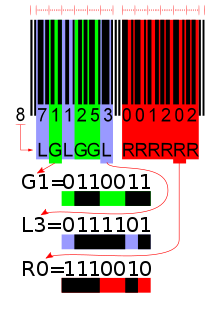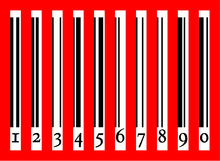国际商品编码

国际商品编码(英语:International Article Number),即欧洲商品编码(European Article Number,EAN),原来只是欧洲范围内商品代码,而现在已是全球范围内产品交易的商品代码。为了适应读码器辨认的需要,这些代码又做成大家熟知的条形码。
另外,日本于1978年在EAN的基础上开发出日本商品编码(Japanese Article Number,JAN)。
代码组成及其意义[编辑]
- 【EAN有8位数字和13位数字之分】
- 13位的组成是这样的:
- 国家代码(前3位)[1]
- 生产商代码(后4位)
国家代码和生产商代码由EAN各国总部具体发放和管理
- 货品代码(再5位)
这5位代码由厂商自行设定
- 计算机校验码(最后1位)
8位的EAN是专门为小商品设置的代码,所以其组成部分和13位EAN是不同的。
- 8位的组成是这样的:
- 国家代码(前3位)
- 生产商代码(后2位)
国家代码和生产商代码由EAN各国总部具体发放和管理
- 货品代码(再2位)
这2位代码由厂商自行设定
- 计算机校验码(最后1位)
会员国列表[编辑]
国家代码只能代表包装该项商品的厂商所在国家(地区),并无法表示出原始生产地。未在下表出现的数字,乃是针对未来使用而保留。
- 000 - 019
 美国
美国 - 020 - 029
Restricted distribution (MO defined) - 030 - 039
 美国
美国 - 040 - 049
Restricted distribution (MO defined) - 050 - 139
 美国
美国 - 200 - 299
Restricted distribution (MO defined) - 300 - 379
 法国
法国 - 380
 保加利亚
保加利亚 - 383
 斯洛文尼亚
斯洛文尼亚 - 385
 克罗地亚
克罗地亚 - 387
 波黑
波黑 - 389
 黑山
黑山 - 390
 科索沃
科索沃 - 400 - 440
 德国
德国 - 450 - 459
 日本
日本 - 460 - 469
 俄罗斯
俄罗斯 - 470
 吉尔吉斯斯坦
吉尔吉斯斯坦 - 471
 台湾
台湾 - 474
 爱沙尼亚
爱沙尼亚 - 475
 拉脱维亚
拉脱维亚 - 476
 阿塞拜疆
阿塞拜疆 - 477
 立陶宛
立陶宛 - 478
 乌兹别克斯坦
乌兹别克斯坦 - 479
 斯里兰卡
斯里兰卡 - 480
 菲律宾
菲律宾 - 481
 白俄罗斯
白俄罗斯 - 482
 乌克兰
乌克兰 - 484
 摩尔多瓦
摩尔多瓦 - 485
 亚美尼亚
亚美尼亚 - 486
 格鲁吉亚
格鲁吉亚 - 487
 哈萨克斯坦
哈萨克斯坦 - 488
 塔吉克斯坦
塔吉克斯坦 - 489
 香港
香港 - 490 - 499
 日本
日本 - 500 - 509
 英国
英国 - 520 - 521
 希腊
希腊 - 528
 黎巴嫩
黎巴嫩 - 529
 塞浦路斯
塞浦路斯 - 530
 阿尔巴尼亚
阿尔巴尼亚 - 531
 北马其顿
北马其顿 - 535
 马耳他
马耳他 - 539
 爱尔兰
爱尔兰 - 540 - 549
 比利时
比利时 卢森堡
卢森堡 - 560
 葡萄牙
葡萄牙 - 569
 冰岛
冰岛 - 570 - 579
 丹麦
丹麦 法罗群岛
法罗群岛 格陵兰
格陵兰 - 590
 波兰
波兰 - 594
 罗马尼亚
罗马尼亚 - 599
 匈牙利
匈牙利 - 600 - 601
 南非
南非 - 603
 加纳
加纳 - 604
 塞内加尔
塞内加尔 - 608
 巴林
巴林 - 609
 毛里求斯
毛里求斯 - 611
 摩纳哥
摩纳哥 - 613
 阿尔及利亚
阿尔及利亚 - 615
 尼日利亚
尼日利亚 - 616
 肯尼亚
肯尼亚 - 618
 象牙海岸
象牙海岸 - 617
 喀麦隆
喀麦隆 - 619
 突尼斯
突尼斯 - 620
 坦桑尼亚
坦桑尼亚 - 621
 叙利亚
叙利亚 - 622
 埃及
埃及 - 623
 文莱
文莱 - 624
 利比亚
利比亚 - 625
 约旦
约旦 - 626
 伊朗
伊朗 - 627
 科威特
科威特 - 628
 沙地阿拉伯
沙地阿拉伯 - 629
 阿联酋
阿联酋 - 630
 卡塔尔
卡塔尔 - 637
 苏格兰
苏格兰 - 640 - 649
 芬兰
芬兰 - 690 - 699
 中国
中国 - 700 - 709
 挪威
挪威 - 729
 以色列
以色列 - 730 - 739
 瑞典
瑞典 - 740
 危地马拉
危地马拉 - 741
 萨尔瓦多
萨尔瓦多 - 742
 洪都拉斯
洪都拉斯 - 743
 尼加拉瓜
尼加拉瓜 - 744
 哥斯达黎加
哥斯达黎加 - 745
 巴拿马
巴拿马 - 746
 多米尼加
多米尼加 - 750
 墨西哥
墨西哥 - 754 - 755
 加拿大
加拿大 - 759
 委内瑞拉
委内瑞拉 - 760 - 769
 瑞士
瑞士 列支敦士登
列支敦士登 - 770 - 771
 哥伦比亚
哥伦比亚 - 773
 乌拉圭
乌拉圭 - 775
 秘鲁
秘鲁 - 777
 玻利维亚
玻利维亚 - 778 - 779
 阿根廷
阿根廷 - 780
 智利
智利 - 784
 巴拉圭
巴拉圭 - 786
 厄瓜多尔
厄瓜多尔 - 789 - 790
 巴西
巴西 - 800 - 839
 意大利
意大利 圣马力诺
圣马力诺 梵蒂冈
梵蒂冈 - 840 - 849
 西班牙
西班牙 安道尔
安道尔 - 850
 古巴
古巴 - 858
 斯洛伐克
斯洛伐克 - 859
 捷克
捷克 - 860
 塞尔维亚
塞尔维亚 - 865
 蒙古国
蒙古国 - 867
 朝鲜
朝鲜 - 868 - 869
 土耳其
土耳其 - 870 - 879
 荷兰
荷兰 - 880
 韩国
韩国 - 883
 缅甸
缅甸 - 884
 柬埔寨
柬埔寨 - 885
 泰国
泰国 - 888
 新加坡
新加坡 - 890
 印度
印度 - 893
 越南
越南 - 896
 巴基斯坦
巴基斯坦 - 899
 印度尼西亚
印度尼西亚 - 900 - 919
 奥地利
奥地利 - 930 - 939
 澳大利亚
澳大利亚 - 940 - 949
 纽西兰
纽西兰 - 950
Global Office - 951
Global Office (EPCglobal) - 952
Global Office (Test) - 955
 马来西亚
马来西亚 - 958
 澳门
澳门 - 960 - 969
Global Office (GTIN-8s) - 977
期刊 (ISSN) - 978 - 979
书籍 (ISBN)[a] - 980
退款收据 - 981 - 984
货币价值票券 - 990 - 999
印花、礼券
EAN的背景[编辑]
早年[编辑]
美国依据1970年IBM乔治·劳雷尔所开发12位数字的通用产品代码(Universal Product Code,缩写“UPC”),在1973年制定为标准,后来重新改划为“UPC-A”[2][3][4]。一年之后,为了和美国能协调一致欧洲也指定了一套类似的货品代码体系。1977年建立了欧洲货品协会European Article Association,其组织成员覆盖了全球98个国家。为了综合美国和欧洲的产品代码,设在美国的“均匀码理事会”(Uniform Code Council, UCC)把现今使用的EAN称为EAN·UCC。
更名[编辑]
1981年,EAN已发展为国际性组织,改名为国际商品编码协会。
现在[编辑]
2005年EAN正式更名为GS1(Global Standard One)。 2005年1月1日起北美洲实行EAN-13的货品代码。
EAN-13 代码[编辑]
在条形码中的应用[编辑]
一位数字由两条明线和两条暗线来定义。
四条线段以最细的一条为标准,分别有一倍、两倍、三倍、四倍四种粗细。
同时一位数字的四条线段加起来的粗度正好是标准线段(最细线段)的七倍。
编码的组成[编辑]




要编码一个13位数字,需要先把这些数字分为3部分:第一个数字,开始6个数字和后6个数字。开始的6个数字有两种编码模式,even模式(标识为G)和odd模式(标识为L)。第一个数字不会直接用G或L模式编码,但决定了开始6数字是用G模式还是L模式。后6个数字都会用RRRRRR模式来编码。 To encode the 13-digit EAN-13 number, the digits are split into 3 groups; the first digit, the first group of 6 and the last group of 6. The first group of 6 is encoded using a pattern whereby each digit has two possible encodings, one of which has even parity (denoted with letter G) and one of which has odd parity (denoted with letter L). The first digit is not represented directly by a pattern of bars and spaces, but is encoded indirectly, by selecting a pattern of choices between these two encodings for the first group of 6 digits, according to the table below. All digits in the last group of 6 digits are encoded using a single pattern RRRRRR, the one also used for UPC.
比如第一个数字为0,那么前6个数字全部使用LLLLLL模式来编码。UPC条码可以理解为一个0开头的EAN13条码。 If the first digit is zero, all digits in the first group of 6 are encoded using the pattern LLLLLL used for UPC, therefore, a UPC barcode is also an EAN-13 barcode with the first digit set to zero.
| First digit | First group of 6 digits | Last group of 6 digits |
|---|---|---|
| 0 | LLLLLL | RRRRRR |
| 1 | LLGLGG | RRRRRR |
| 2 | LLGGLG | RRRRRR |
| 3 | LLGGGL | RRRRRR |
| 4 | LGLLGG | RRRRRR |
| 5 | LGGLLG | RRRRRR |
| 6 | LGGGLL | RRRRRR |
| 7 | LGLGLG | RRRRRR |
| 8 | LGLGGL | RRRRRR |
| 9 | LGGLGL | RRRRRR |
This encoding guarantees that the first group always starts with an L-code, which has odd parity, and that the second group always starts with an R-code, which has even parity. Thus, it does not matter whether the barcode is scanned from the left or from the right, as the scanning software can use this parity to identify the start and end of the code.
EAN-8 barcodes encode all digits directly, using this scheme:
| First group of 4 digits | Last group of 4 digits |
|---|---|
| LLLL | RRRR |
| Digit | L-code | G-code | R-code |
|---|---|---|---|
| 0 | 0001101 | 0100111 | 1110010 |
| 1 | 0011001 | 0110011 | 1100110 |
| 2 | 0010011 | 0011011 | 1101100 |
| 3 | 0111101 | 0100001 | 1000010 |
| 4 | 0100011 | 0011101 | 1011100 |
| 5 | 0110001 | 0111001 | 1001110 |
| 6 | 0101111 | 0000101 | 1010000 |
| 7 | 0111011 | 0010001 | 1000100 |
| 8 | 0110111 | 0001001 | 1001000 |
| 9 | 0001011 | 0010111 | 1110100 |
Note: Entries in the R-column are bitwise complements (logical operator: negation) of the respective entries in the L-column. Entries in the G-column are the entries in the R-column in reverse bit order. See pictures of all codes against a colored background.
A run of one or more black areas is known as a "bar", and a run of one or more white areas is known as a "space". As can be seen in the table, each digit's encoding comprises two bars and two spaces, and the maximum width of a bar or space is four areas.
校验码的计算方法[编辑]
- 例子:假设某国际商品编码的前 12 位是:490-8569-21968;
- 计算加权和:
- 校验码即为加权和除以 10 的负余数:。
所以,范例的校验码是 9,完整的国际商品编码为 490-8569-21968-9。
外部链接[编辑]
- (英文)GS1 (页面存档备份,存于互联网档案馆)
- (简体中文)GS1 China 中华人民共和国物品编码中心 (页面存档备份,存于互联网档案馆)
- (中文)GS1 Taiwan 财团法人中华民国商品编码策进会 (页面存档备份,存于互联网档案馆)
- (中文)GS1 Hong Kong 香港货品编码协会 (页面存档备份,存于互联网档案馆)
- (中文)GS1 Macau 澳门 (页面存档备份,存于互联网档案馆)
- (英文)GS1 Singapore 新加坡 (页面存档备份,存于互联网档案馆)
- (英文)BarcodeRobot (页面存档备份,存于互联网档案馆)
参考来源[编辑]
- 注释
- ^ 979-0特意留空,给予国际标准音乐出版物编码(ISMN)使用。
- 引用
- ^ Prefix List, GS1, [2017-01-03], (原始内容存档于2014-12-28).
- ^ Alumni Hall of Fame Members. University of Maryland Alumni Association. The University of Maryland. 2005 [2009-06-10]. (原始内容存档于2007-06-23).
After graduating from Maryland in 1951, George Laurer joined IBM as a junior engineer and worked up the ranks to senior engineer. In 1969, he returned to the technical side of engineering and was later assigned the monumental task of designing a code and symbol for product identification for the Uniform Grocery Product Code Council. His solution — the Universal Product Code — radically changed the retail world. Since then, he has enhanced the code by adding a 13th digit. Laurer retired from IBM in 1987. He holds some 25 patents and is a member of the university’s A. James Clark School of Engineering Hall of Fame.
- ^ 商品條碼發起人Alan Haberman與世長辭. Unwire.hk. 2011年6月17日 [2017-01-03]. (原始内容存档于2017-01-04).
- ^ MARGALIT FOX. 现代条形码发明者伍德兰去世. 纽约时报中文网. 2012年12月17日 [2017-01-03]. (原始内容存档于2017-01-04). ([//web.archive.org/web/20170104000906/http://cn.nytimes.com/obits/20121217/c17woodland-obit/zh-hant/ 页面存档备份,存于互联网档案馆) (页面存档备份,存于互联网档案馆) (页面存档备份,存于互联网档案馆) (页面存档备份,存于互联网档案馆) (繁体中文)] (页面存档备份,存于互联网档案馆)
| |||||||||||||||||||||||||||||||||||||||||||||||||||




